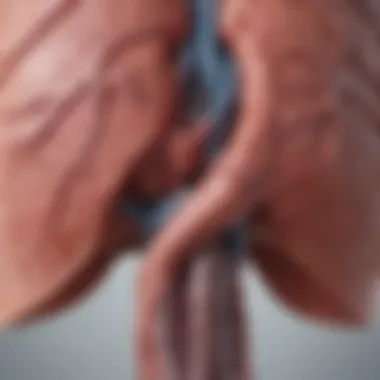New Insights and Advances in Cirrhosis Research


Intro
Cirrhosis of the liver remains a significant health challenge globally. As a chronic condition, it’s characterized by progressive scarring of liver tissue, which disrupts normal function and leads to various complications. Recent research has transformed our understanding of this disease, providing deeper insights into its mechanisms, diagnosis, and treatment options. In this article, we aim to present the latest findings that illuminate the current landscape of cirrhosis. The goal is to offer a rich overview, essential for professionals, researchers, and educators in this field.
Research Overview
Summary of Key Findings
The latest studies on liver cirrhosis reveal several crucial advancements:
- Pathophysiology: New insights into the molecular mechanisms behind cirrhosis highlight the importance of inflammation and fibrosis.
- Diagnostic Techniques: Improved imaging modalities and biomarkers enhance early detection and monitoring of disease progression.
- Therapeutic Options: There is a shift towards personalized medicine, where treatments are tailored based on individual patient profiles.
These findings collectively demonstrate an evolving understanding that could profoundly impact clinical practices.
Methodologies Employed
Research on cirrhosis has employed various methodologies:
- Clinical Studies: Observational studies provide real-world insights into the disease's progression and treatment efficacy.
- Laboratory Research: In vitro and in vivo studies help to elucidate molecular pathways involved in liver injury and repair.
- Meta-Analyses: Aggregated data from multiple studies offer a broader perspective on treatment outcomes and risk factors.
"Recent advancements in cirrhosis research are paving the way for improved clinical outcomes through better diagnostics and targeted therapies."
In-Depth Analysis
Detailed Examination of Results
By examining specific studies, we find notable results:
- Liver Biopsy vs. Non-Invasive Methods: Non-invasive techniques, such as elastography, show comparable sensitivity to traditional biopsies. This offers a safer, more patient-friendly option.
- Emerging Biomarkers: Certain biomarkers are gaining traction as predictors of progression in cirrhosis, aiding physicians in decision-making.
Comparison with Previous Studies
Previous research has often focused on the end-stage consequences of cirrhosis. The recent studies emphasize preventive measures and the importance of early intervention. They paint a different picture, shifting the narrative towards understanding circirhotic progression from a more proactive angle. New data suggests that addressing liver health at earlier stages is vital for better outcomes.
Prologue to Cirrhosis
Cirrhosis is a significant public health issue, representing a late stage of chronic liver disease. This article aims to shed light on the complexities surrounding this condition, emphasizing both the recent advancements in our understanding of its pathology and the innovations in diagnosis and treatment. The increasing prevalence of cirrhosis, driven by factors like viral hepatitis, alcohol consumption, and metabolic conditions, highlights the importance of comprehensive research. As medical and scientific communities strive to improve patient outcomes, it is crucial to explore the mechanisms underpinning cirrhosis, as well as its epidemiology and management strategies.
Understanding Cirrhosis
Cirrhosis is characterized by the progressive degeneration of liver tissue, leading to fibrosis and structural changes. When functional liver cells die due to injury or disease, scar tissue forms, disrupting normal liver functions. Understanding these processes provides a foundation for exploring potential treatments. The pathophysiology of cirrhosis is not uniform; it varies based on underlying causes and individual biological responses. Grasping these fundamental aspects equips healthcare professionals to tailor interventions for their patients.
Key points to understand about cirrhosis include:
- Liver Function: The liver plays a critical role in metabolism, detoxification, and protein synthesis.
- Causes: Major contributors to cirrhosis include viral infections, excessive alcohol intake, and non-alcoholic fatty liver disease.
- Symptoms: Early stages may be asymptomatic, but as it progresses, symptoms such as fatigue, jaundice, and portal hypertension emerge.
Epidemiology of Cirrhosis
Cirrhosis has a high burden on global health systems. The World Health Organization reports that liver diseases, including cirrhosis, account for millions of deaths annually. Understanding the epidemiology involves analyzing various demographic factors that influence incidence and outcomes. Age, sex, and socio-economic status can all impact susceptibility to liver diseases. For instance, men are generally at higher risk than women, largely due to alcohol-related causes.
Recent studies indicate a rising trend in cirrhosis cases, particularly in developing regions. Population growth and changes in lifestyle contribute to this increase. Moreover, despite advancements in treatment, morbidity and mortality rates from liver disease continue to pose challenges.
The data suggests that:
- Chronic viral hepatitis remains a leading cause worldwide.
- Obesity and metabolic syndrome lead to an increased risk of non-alcoholic fatty liver disease, which can progress to cirrhosis.
- Alcohol-related liver disease continues to be prevalent, with rising consumption patterns in various demographics.
Pathophysiological Mechanisms


Understanding the pathophysiological mechanisms involved in cirrhosis is vital. This knowledge improves diagnosis and treatments. Cirrhosis results from various conditions that gradually damage the liver. Over time, this leads to fibrosis, inflammation, and significant cellular changes. Such insights are essential for developing effective therapeutic strategies.
Liver Fibrosis and Scarring
Liver fibrosis occurs when the liver attempts to heal after injury. It forms scar tissue, which disrupts the liver's structure and function. Fibrosis is a response to chronic damage from factors like viral infections or alcoholic liver disease. Monitoring fibrosis is crucial for assessing disease progression. New techniques, such as elastography, are emerging to non-invasively measure liver stiffness, an indicator of fibrosis.
- Fibrosis Stages:
Different stages define the severity of fibrosis:
- F0 - No fibrosis
- F1 - Mild fibrosis
- F2 - Moderate fibrosis
- F3 - Severe fibrosis
- F4 - Cirrhosis
Inflammation and Immune Response
Inflammation plays a central role in the progression of cirrhosis. When liver damage occurs, the body initiates an immune response to promote healing. However, persistent inflammation can worsen fibrosis. Researchers are now exploring the connection between immune activation and liver disease progression. Hepatic macrophages, lymphocytes, and other cells contribute to inflammation, making targeted therapies a focus of recent studies.
Chronic inflammation not only drives liver damage but also contributes to potential complications, such as hepatocellular carcinoma.
Cellular Changes in Chronic Damage
Chronic liver damage leads to distinct cellular alterations within the liver tissue. Hepatocytes undergo changes, affecting their function and viability. Also, hepatic stellate cells become activated, promoting fibrosis. Understanding these cellular processes helps in identifying potential therapeutic targets. The ongoing research emphasizes the necessity of unveiling these mechanisms to develop novel treatment strategies.
In summary, the pathophysiological mechanisms of cirrhosis include fibrosis, inflammation, and cellular changes. Each element plays a role in disease progression and has implications for diagnosis and treatment. Enhancing our understanding of these mechanisms is crucial for improving patient outcomes.
Recent Advances in Diagnosis
The diagnosis of cirrhosis has often been a complex and challenging task for clinicians. Understanding the recent advances in diagnosis is crucial for improving patient outcomes and tailoring appropriate interventions. Early detection of cirrhosis can lead to timely treatment, potentially slowing the progression of the disease. Techniques and methods developed in recent years provide better accuracy and efficiency when evaluating liver health. This section focuses on three pivotal advancements: biomarkers, imaging techniques, and histopathological assessment.
Biomarkers in Cirrhosis
Recent studies have highlighted the potential of biomarkers in aiding the diagnosis and management of cirrhosis. Biomarkers are biological factors that can indicate the presence or severity of a disease. In cirrhosis, specific biomarkers can reflect liver damage and fibrosis progression.
Some notable biomarkers include:
- Fibrosis-4 (FIB-4): This index uses age, aspartate aminotransferase (AST), alanine aminotransferase (ALT), and platelet count to assess fibrosis risk.
- Non-alcoholic fatty liver disease (NAFLD) fibrosis score: This score considers metabolic factors to evaluate the risk of fibrosis in patients with fatty liver disease.
These biomarkers facilitate non-invasive assessments, reducing the need for liver biopsies, which carry associated risks. Physicians can use these tools to monitor disease progression and determine the appropriateness of different therapeutic strategies.
Imaging Techniques
Imaging technology has advanced significantly in diagnosing liver cirrhosis. Non-invasive imaging techniques provide valuable insights into hepatic architecture and functionality. The following are some of the leading imaging modalities used in diagnosis:
- Ultrasound: This is often the first-line imaging method. It helps visualize liver size, texture, and the presence of nodules, which may suggest cirrhosis.
- Magnetic Resonance Imaging (MRI): With greater detail, MRI can assess liver structure without ionizing radiation. It is effective in identifying liver lesions and evaluating liver fat content.
- Computed Tomography (CT): CT scans provide high-resolution images and can detect changes in liver tissue associated with cirrhosis.
These imaging modalities enhance the clinician's ability to diagnose cirrhosis earlier and more precisely, which is vital for timely interventions.
Histopathological Assessment
Histopathological assessment remains a cornerstone in the definitive diagnosis of cirrhosis. Through liver biopsy, pathologists can evaluate tissue specimens at a cellular level.
Recent advancements in histopathological techniques include:
- Automated digital pathology: This technology allows for more accurate evaluations of liver tissue samples, improving assessment consistency.
- Liver biopsy scoring systems: Systems like the METAVIR scoring system enable pathologists to quantify the degree of fibrosis and inflammation, which is crucial for diagnosis and monitoring.
While liver biopsy is an invasive procedure, ongoing developments aim to minimize its risks and complications. The integration of traditional histopathology with new technologies strengthens the pathway towards accurate cirrhosis diagnosis, ensuring better management strategies.
Overall, these advancements in diagnosis signify a paradigm shift in the evaluation of cirrhosis, promising to improve patient care significantly.
By combining biomarkers, imaging techniques, and histopathological assessments, physicians can achieve a better understanding of the disease progression and respond accordingly.


Emerging Therapeutic Strategies
The treatment landscape for cirrhosis of the liver is gradually evolving, influenced by ongoing research and clinical trials. Emerging therapeutic strategies are essential because they offer new hope for managing this complex condition. As our understanding of the disease progresses, it is crucial to explore these strategies, providing patients with effective options that align with their needs. Each treatment approach examines various aspects of the disease, factoring in patient-specific considerations and potential benefits.
Pharmacological Treatments
Pharmacological interventions have seen significant advancements in recent years. New medications, such as direct-acting antivirals for viral hepatitis, have shown promise in reversing liver damage and improving liver function. Moreover, antifibrotic drugs are being investigated to mitigate liver fibrosis, which is a key feature of cirrhosis. These treatments offer various mechanisms of action, targeting underlying issues contributing to cirrhosis.
Benefits of pharmacological treatments include:
- Reduction in Disease Progression: These medications can slow the progression of cirrhosis and prevent complications.
- Improved Quality of Life: Patients often experience fewer symptoms and improved well-being.
- Potential for Liver Regeneration: Some newer drugs may help in restoring liver architecture, making transplant options more favorable.
Nevertheless, healthcare professionals must evaluate each treatment's appropriateness based on individual patient profiles, including comorbid conditions and potential drug interactions.
Nutritional Interventions
Nutrition plays a pivotal role in managing liver health in cirrhosis patients. Tailored dietary interventions can help improve overall health, support liver function, and reduce symptoms related to the condition. Nutritional therapy focuses on ensuring adequate caloric intake and providing essential nutrients to counter malnutrition common in liver disease.
Key aspects of nutritional interventions include:
- Dietary Modifications: Low-sodium diets can help manage fluid retention, while sufficient protein intake is vital for muscle preservation.
- Micronutrient Supplementation: Vitamins and minerals, particularly those lacking in cirrhotic patients, are crucial.
- Monitoring and Adjustments: Regular assessments can help tailor diets to the changing needs of the patient.
By leveraging nutritional support, healthcare professionals can improve patients’ resilience against the effects of cirrhosis and promote better visual outcomes.
Innovative Surgical Techniques
In circumstances where pharmacological and nutritional strategies are insufficient, innovative surgical techniques may come into play. These approaches aim to manage complications and enhance liver function. Recent advancements include minimally invasive surgical options that pose fewer risks than traditional surgeries.
Important surgical strategies include:
- Liver Transplantation: This remains the ultimate treatment for end-stage liver disease. New protocols aim at reducing wait times and improving transplant outcomes.
- Transjugular Intrahepatic Portosystemic Shunt (TIPS): This procedure helps manage portal hypertension, a frequent complication in cirrhotic patients.
- Innovative Approaches: Research is underway into bioengineered liver tissues and transplant innovation to address donor shortages.
Each of these techniques aims for improved patient longevity and quality of life. Despite the benefits, they require careful patient selection and multidisciplinary coordination to ensure optimal outcomes.
Implications for Patient Care
The implications for patient care in the context of cirrhosis are profound and multi-faceted. Understanding cirrhosis is not only about recognizing its symptoms or stages but also involves comprehensive care approaches that can significantly improve outcomes for patients. Effective care strategies can lead to better management of the disease, reduced hospitalizations, and improved quality of life.
Multidisciplinary Approaches
A multidisciplinary approach is crucial in managing cirrhosis. It integrates various specialties, allowing for holistic care that acknowledges the complexity of the disease. This model includes:
- Gastroenterologists who specialize in liver conditions.
- Nutritionists who can address dietary needs that affect liver health.
- Psychologists to help with mental health issues associated with chronic illness.
- Social workers who assist with navigating healthcare systems and community resources.
Bringing together professionals from different fields ensures that all aspects of a patient's health are addressed. This team-oriented care allows for tailored treatment plans that maximize patient engagement and adherence to therapies. Moreover, better communication between team members can help identify and mitigate complications before they escalate.
Patient Education and Support
Educating patients about their condition is an essential component of care. Cirrhosis patients often face complex medical information that can be challenging to understand. Proper education empowers patients to:
- Understand the importance of medication adherence.
- Recognize signs of decompensation.
- Make informed decisions regarding lifestyle changes, including diet and alcohol consumption.
Support systems also play a vital role in the management of cirrhosis. Support groups can provide emotional relief by connecting patients with others facing similar challenges. Access to educational materials such as brochures, workshops, and online resources can also be beneficial. Putting these strategies together can lead to a more comprehensive approach to care, which ultimately benefits both the patient and the healthcare system as a whole.
"Effective patient education is the key to success in managing chronic liver disease. Patients who are well-informed are more likely to engage in their own care."
By prioritizing patient education and incorporating multidisciplinary approaches, healthcare providers can greatly influence the trajectory of cirrhosis management. These factors not only enhance care quality but also align with the growing emphasis on patient-centered care models.


Public Health Considerations
Examining cirrhosis of the liver through a public health lens is crucial. Cirrhosis significantly impacts health outcomes at both individual and societal levels. Understanding the multifaceted aspects of cirrhosis can optimize care, improve early detection, and provide avenues for efficient intervention. There are several key elements that underscore the relevance of addressing liver cirrhosis in public health initiatives.
Prevention Strategies
Effective prevention strategies play a vital role in tackling cirrhosis. These strategies focus on reducing risk factors that lead to liver damage and subsequent cirrhosis. Some essential prevention methods include:
- Education on Alcohol Consumption: Promoting responsible drinking can lower instances of alcoholic liver disease.
- Vaccination Against Hepatitis: Vaccines for Hepatitis A and B can prevent viral infections that damage the liver.
- Screening Programs: Early detection through regular screening for at-risk populations can identify liver disease before it advances.
- Healthy Lifestyle Promotion: Encouraging balanced diets and regular exercise helps in maintaining a healthy body weight, minimizing non-alcoholic fatty liver disease.
- Access to Healthcare: Enhancing availability and affordability of healthcare services aids in timely interventions and management of liver health.
Implementing these strategies not only helps to prevent cirrhosis but also promotes overall community health.
Policy Implications
The policies surrounding cirrhosis prevention and management must consider emerging research findings and public health recommendations. Policymakers can enhance health outcomes through informed decision-making. Some pertinent policy implications include:
- Funding for Research: Allocating resources for liver disease research can uncover innovative treatment options and preventive measures.
- Health Education Legislation: Laws promoting education campaigns on liver health and prevention of cirrhosis can raise awareness among the public.
- Support for Substance Abuse Programs: Investing in addiction treatment programs can reduce liver-related diseases caused by excessive alcohol consumption.
- Incentives for Health Promotion: Policies that support organizations aimed at promoting liver health can further drive community engagement.
The integration of these policies, based on current evidence, can substantially mitigate the impact of cirrhosis on public health, leading to better health outcomes for various populations.
Future Directions in Cirrhosis Research
The field of cirrhosis research is rapidly evolving. Understanding where future investigations will lead is crucial for medical advancements and improved patient outcomes. As our comprehension of the liver's complexities deepens, so does the importance of targeting research towards more effective diagnosis, treatment, and prevention strategies. Focusing on specific areas can yield significant benefits, including enhanced therapeutic approaches and ultimately better prognoses for patients suffering from this chronic ailment.
Ongoing Clinical Trials
Clinical trials play a pivotal role in shaping future treatment protocols for cirrhosis. Many ongoing clinical trials are focused on innovative drugs that target different aspects of liver pathology. New pharmacological agents under investigation may include antifibrotic drugs, which aim to halt or reverse fibrosis progression. Others explore combination therapies that could tackle multiple pathways involved in liver damage. As these trials generate data, they will inform clinical practices, leading to more personalized treatment approaches for patients.
The significance of such trials cannot be overstated. They provide necessary insights into drug efficacy and safety, thus offering hope for improved management of cirrhosis. Key areas explored in the clinical trials include:
- Identification of effective dosage regimens
- Assessment of long-term outcomes
- Evaluation of quality of life post-treatment
These components are vital for developing comprehensive treatment frameworks that enhance patient care.
Areas Requiring Further Investigation
Despite the advancements in understanding and treating cirrhosis, several areas still need more investigation. Research gaps exist in the following domains:
- Biomarker Development: There is a pressing need to develop reliable biomarkers for early detection and monitoring of cirrhosis. Future research must focus on identifying specific biological markers that can indicate disease progression and response to treatment.
- Genomic Studies: Large-scale genomic studies could shed light on the genetic predispositions that contribute to cirrhosis. Understanding the genetic factors involved may lead to tailored therapies that consider individual patient profiles.
- Psychosocial Factors: The impact of psychosocial elements on the management of cirrhosis is not fully explored. Research should integrate dimensions such as mental health and social support to develop holistic care models.
Exploring these areas can provide a more rounded understanding of cirrhosis, ultimately leading to improved therapies and better patient outcomes.
"The future of cirrhosis research hinges on interdisciplinary approaches that address both biological and patient-oriented aspects."
In summary, advancing cirrhosis research is paramount. Ongoing clinical trials and new avenues for investigation will provide the data needed to optimize care for individuals affected by this condition.
The End
The conclusion of this article synthesizes the critical information presented regarding cirrhosis of the liver, emphasizing the ongoing developments in research and treatment. It reflects the significance of understanding cirrhosis not only as a medical condition but as a multifaceted challenge affecting individuals and public health systems.
Summary of Key Findings
Recent studies elucidate the complex mechanisms of liver cirrhosis. They underscore the impact of various factors including alcohol use, viral infections, and metabolic disorders. Key insights include:
- Pathophysiology: Advances reveal the intricate processes of inflammation, fibrosis, and cellular degeneration, which contribute to the progression of cirrhosis.
- Diagnostic Techniques: Innovative imaging methods and the identification of specific biomarkers enhance early detection. These advancements improve patient outcomes by facilitating timely interventions.
- Therapeutic Strategies: Emerging pharmacological treatments, nutritional therapies, and innovative surgical techniques offer new hope. Research focuses on individualized therapy, aiming to improve the quality of life for patients.
These findings indicate a shifting paradigm in the approach to cirrhosis, moving from reactive to proactive management.
Broader Implications for Health Care
Understanding cirrhosis requires a holistic perspective, considering not just the disease but the broader health care implications.
- Public Health Policy: With rising incidences, public health strategies must focus on prevention. Educational programs emphasizing liver health can decrease the disease burden.
- Multidisciplinary Care: Effective management involves collaboration among hepatologists, nutritionists, and mental health professionals. This approach fosters comprehensive care tailored to the individual's needs.
- Patient Empowerment: Educating patients about their condition is essential. Informed patients are more likely to adhere to treatment regimes and engage in healthier lifestyle choices, ultimately improving their prognosis.















